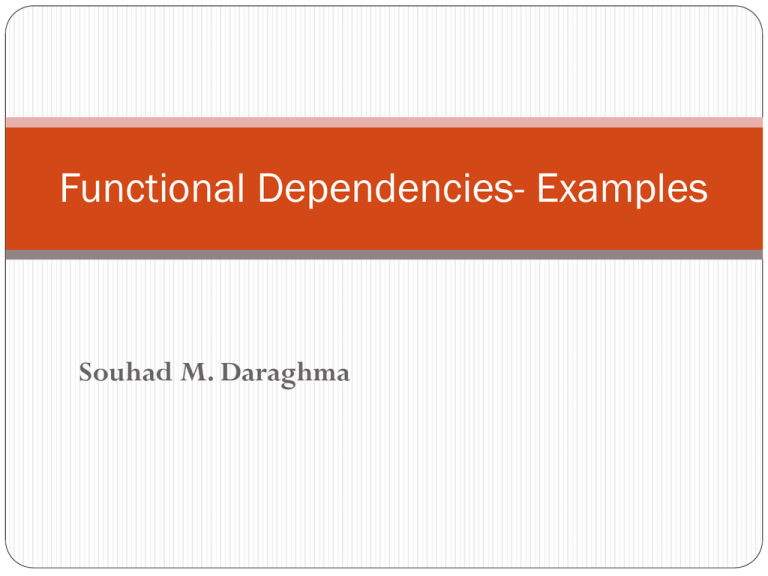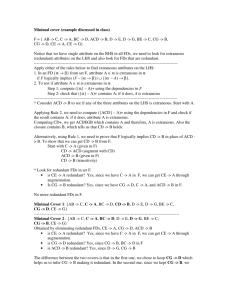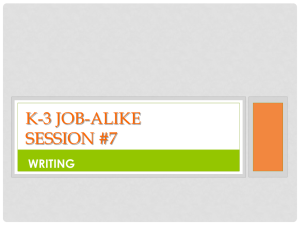FD_Keys
advertisement

Functional Dependencies- Examples
Souhad M. Daraghma
Exercise #1: FD’s From DB Instances
1.
2.
3.
Below is an instance of R(A1,A2,A3,A4). Choose the FD
which may hold on R
A4 A1
A2A3 A4
A2A3 A1
Solution #1: FD’s From DB Instances
1. A4 A1 ???
Incorrect: The 1st and 4th tuple violates it
2. A2A3 A4 ???
Incorrect: The1st and 2nd tuple violates it.
3. A2A3 A1 ???
Correct!
Uses of Attribute Closure
There are several uses of the attribute closure algorithm:
Testing for superkey:
To test if is a superkey, we compute +, and check if
+ contains all attributes of R.
Testing functional dependencies
To check if a functional dependency holds (or,
in other words, is in F+), just check if +.
That is, we compute + by using attribute closure, and
then check if it contains .
Is a simple and cheap test, and very useful
Uses of Attribute Closure
There are several uses of the attribute closure algorithm:
Computing closure of F
For each R, we find the closure +, and for each S
+, we output a functional dependency S.
Exercise #2: Checking if an FD Holds on F
Using the Closure
Let R(ABCDEFGH) satisfy the following functional
dependencies: {A->B, CH->A, B->E, BD->C, EG->H,
DE->F}
Which of the following FD is also guaranteed to be
satisfied by R?
1. BFG AE
2. ACG DH Hint: Compute the closure of the LHS
of each FD that you get as a choice.
3. CEG AB If the RHS of the candidate FD is
contained in the closure, then the
candidate follows from the given FDs,
otherwise not.
6
Solution #2: Checking if an FD Holds on F
Using the Closure
FDs: {A->B, CH->A, B->E, BD->C, EG->H, DE->F}
1. BFG AE ???
Incorrect: BFG+ = BFGEH, which includes E, but not A
2. ACG DH ???
Incorrect: ACG+ = ACGBE, which includes neither D nor H.
3. CEG AB ???
Correct: CEG+ = CEGHAB, which contains AB
7
Exercise #3: Checking for Keys Using the Closure
Which of the following could be a key for R(A,B,C,D,E,F,G)
with functional dependencies {ABC, CDE, EFG,
FGE, DEC, and BCA}
1. BDF
2. ACDF
3. ABDFG
4. BDFG
Solution #3: Checking for Keys Using the Closure
{AB->C, CD->E, EF->G, FG->E, DE->C, and BC->A}
1. BDF ???
No. BDF+ = BDF
2. ACDF ???
No. ACDF+ = ACDFEG (The closure does not include B)
3. ABDFG ???
No. This choice is a superkey, but it has proper subsets that
are also keys (e.g. BDFG+ = BDFGECA)
Solution #3: Checking for Keys Using the Closure
{AB->C, CD->E, EF->G, FG->E, DE->C, and BC->A}
4. BDFG ???
BDFG+ = ABCDEFG
Check if any subset of BDFG is a key:
Since B, D, F never appear on the RHS of the FDs, they must form
part of the key.
BDF+ = BDF Not key
So, BDFG is the minimal key, hence the candidate key
Finding Keys using FDs
Tricks for finding the key:
If an attribute never appears on the RHS of any FD, it must be
part of the key
If an attribute never appears on the LHS of any FD, but
appears on the RHS of any FD, it must not be part of any key
Exercise #4: Checking for Keys Using the Closure
Consider R = {A, B, C, D, E, F, G, H} with a set of FDs
F = {CD→A, EC→H, GHB→AB, C→D, EG→A,
H→B, BE→CD, EC→B}
Find all the candidate keys of R
Solution #4: Checking for Keys Using the Closure
F = {CD→A, EC→H, GHB→AB, C→D, EG→A, H→B,
BE→CD, EC→B}
First, we notice that:
EFG never appear on RHS of any FD. So, EFG must be part of
ANY key of R
A never appears on LHS of any FD, but appears on RHS of
some FD. So, A is not part of ANY key of R
We now see if EFG is itself a key…
EFG+ = EFGA ≠ R; So, EFG alone is not key
Solution #4: Checking for Keys Using the Closure
Checking by adding single attribute with EFG (except A):
BEFG+ = ABCDEFGH = R; it’s a key [BE→CD, EG→A,
EC→H]
CEFG+ = ABCDEFGH = R; it’s a key [EG→A, EC→H, H→B,
BE→CD]
DEFG+ = ADEFG ≠ R; it’s not a key [EG→A]
EFGH+ = ABCDEFGH = R; it’s a key [EG→A, H→B, BE→CD]
If we add any further attribute(s), they will form the superkey.
Therefore, we can stop here searching for candidate key(s).
Therefore, candidate keys are: {BEFG, CEFG, EFGH}
Exercise #5: Checking for Keys Using the Closure
Consider R = {A, B, C, D, E, F, G} with a set of FDs
F = {ABC→DE, AB→D, DE→ABCF, E→C}
Find all the candidate keys of R
Solution #5: Checking for Keys Using the Closure
F = {ABC→DE, AB→D, DE→ABCF, E→C}
First, we notice that:
G never appears on RHS of any FD. So, G must be part of ANY
key of R.
F never appears on LHS of any FD, but appears on RHS of some
FD. So, F is not part of ANY key of R
G+ = G ≠ R
So, G alone is not a key!
Solution #5: Checking for Keys Using the Closure
Now we try to find keys by adding more attributes (except F) to G
Add LHS of FDs that have only one attribute (E in E→C):
GE+ = GEC ≠ R
Add LHS of FDs that have two attributes (AB in AB→D and DE in DE→ABCF):
GAB+ = GABD
GDE+ = ABCDEFG = R; [DE→ABCF] It’s a key!
Add LHS of FDs that have three attributes (ABC in ABC→DE), but not taking
super set of GDE:
GABC+ = ABCDEFG = R; [ABC→DE, DE→ABCF] It’s a key!
GABE+ = ABCDEFG = R; [AB→D, DE→ABCF]
It’s a key!
If we add any further attribute(s), they will form the superkey. Therefore, we can
stop here.
The candidate key(s) are {GDE, GABC, GABE}
Exercise #7: Calculating F+ for a Sub-Relations
Consider R = {A, B, C, D, E} with a set of FDs F =
{AB→DE, C→E, D→C, E→A}
And we wish to project those FDs onto relation S={A, B, C}
Give the FDs that hold in S
Hint:
We need to compute the closure of all the subsets of {A, B,
C}, except the empty set and ABC.
Then, we ignore the FD’s that are trivial and those that have
D or E on the RHS
Solution #7: Calculating F+ for a Sub-Relations
R = {A, B, C, D, E}
F = {AB→DE, C→E, D→C, E→A}
S={A, B, C}
A+ = A
B+ = B
C+ = CEA [C→E, E→A]
AB+ = ABDEC [AB→DE, D→C]
AC+ = ACE [C→E]
BC+ = BCEAD [C→E, E→A, AB→DE]
We ignore D and E.
So, the FDs that hold in S are:
{C→A, AB→C, BC→A}
(Note: BC→A can be ignored because it follows logically from C→A)
Canonical Cover
Sets of functional dependencies may have redundant
dependencies that can be inferred from the others
Eg: A C is redundant in: {A B, B C, A C}
Parts of a functional dependency may be redundant
E.g. on RHS: {A B, B C, A CD} can be simplified to
{A B, B C, A D}
E.g. on LHS: {A B, B C, AC D} can be simplified to
{A B, B C, A D}
Intuitively, a canonical cover of F is a “minimal” set of
functional dependencies equivalent to F, having no redundant
dependencies or redundant parts of dependencies










